In October, the Council elected Dr. Mario Motta the first President of the second century of the AAVSO. In November, I interviewed Mario to find out more about the man who will be presiding over the Council for the next couple years.
Dr. Motta has become well known for his efforts to stem light pollution and, as a practicing cardiologist, has written papers and articles on the medical effects of light pollution. Mario has also been involved in education and outreach, receiving the Las Cumbres Amateur Outreach Award from the Astronomical Society of the Pacific in 2003.
Mario has been an amateur astronomer and telescope maker for a long time. He has been a member of the Amateur Telescope Makers of Boston for decades and has made several telescopes, including his most recent effort, a 32-inch relay telescope that was featured in Sky and Telescope magazine in May 2011.
Oddly enough, his ATM experience is how he got involved in the AAVSO. “I finished my residency in 1983 and my 16-inch telescope about the same time. I met Janet, and she started leaning on me that I should do more than just look at the sky and take pretty pictures.” By 1985 Mario was a member of the AAVSO.
Being a doctor and a telescope maker hasn’t left a lot of time for observing. “I don’t follow long period variables or anything”, Mario said. “Having a large telescope, what I would like to do is support campaigns on faint objects for the time they are needed as much as possible. My schedule and responsibilities don’t usually allow me to devote a specific time and a specific night to a target, and being in the Northeast, the weather isn’t very accommodating to that kind of observing either.”
Mario served on the Council before, from 1996 -2000. I asked Mario what compelled him to serve again, as an officer of the AAVSO when he doesn’t even have as much time to observe as he’d like to invest.
“The AAVSO is a worthy organization, and I would like to give back something to what I consider to be one of the finest organizations on the planet.” Mario continued, “An organization can only be as good as the people in it. That is one of the organizations main strengths. The AAVSO, from the staff level to the observers, is made up of people who are dedicated, very good people, who work tirelessly for the betterment of the organization.”
There has been some discussion lately about whether or not the AAVSO is a membership organization or serves some other purpose, like pure science. Where does the Council President stand on that issue?
“I personally think we need to collect the data for the science. Members can get satisfaction from plotting their data in light curves and seeing them used for research.” Mario went on to say, “We would have no international stature if this were done solely for the members. Our stature arises from the fact that the data is scientifically valid, and collected and made available to researchers.”
“I understand why members would want it to be more member-centric, and I think it does serve the members well, but the primary purpose has to be the collection of the data, or quite frankly, it doesn’t need to exist. There are lots of membership organizations in the world. There are very few that produce data that is useful to so many different organizations and people.”
Mario doesn’t think surveys coming online in the future, like LSST, pose a threat to the AAVSO or its observers. To the contrary, he feels it will provide even more opportunities and thinks the challenge to come is getting more people involved in observing and following up on the exciting discoveries LSST is going to make.
“There is always more to do than is humanly possible. The expectations out there are always greater than what we can accomplish. We could always use more money, more staff, more organization”, Mario said, “ But we have to live with the limitations we have. We’ll need to continue to use the assets we have to do the best we can, and I think we’ve done a very good job harboring the assets we have to do as much as we do.”

When he’s not saving lives, fighting light pollution or building his next behemoth telescope, Mario does get to observe with his 32-inch, conveniently located inside the observatory in his home. He’s been observing some supernovae lately. His picture of SN2011dh is featured online, in Sky and Telescope Editor’s Choice Archive, and he has observations of SN2011fe in the AID. But, what is Mario’s favorite variable star?
“I’ve done several personal campaigns on CH Cygni, and published papers on it, so that would have to be my favorite variable star.”
When asked if he had any advice or words of wisdom for the members, Dr. Motta said, “There is no way of knowing what data will be interesting to scientists 10, 20 or 50 years from now, so don’t worry about it so much. I think everyone should find a niche they enjoy and keep plugging away. In the end, you will be rewarded in heaven for everything you do.”

